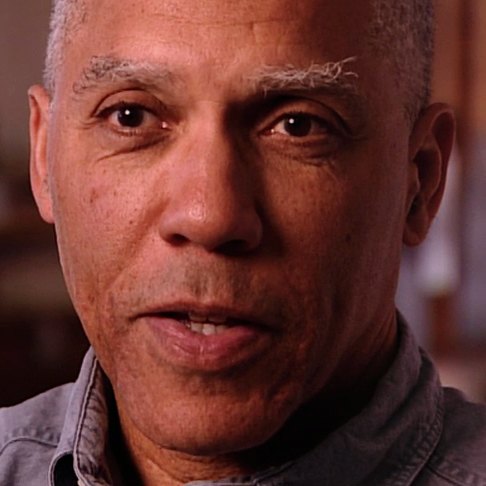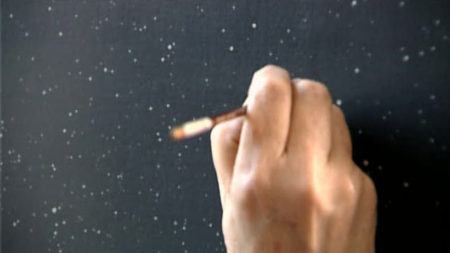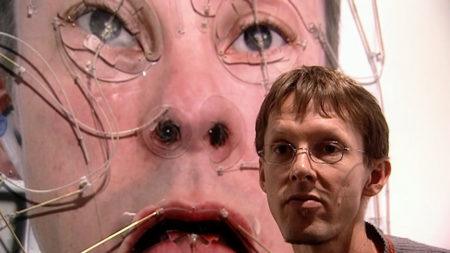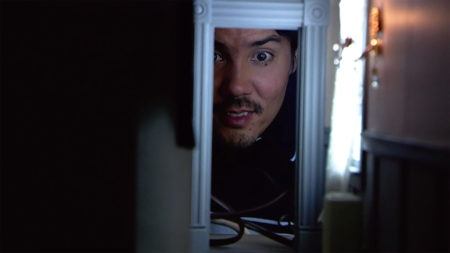Continue playing
(Time remaining: )
Play from beginning
Continue playing "{{ controller.videos[controller.getVideo(controller.currentVideo)].segmentParentTitle}}"
{{controller.videos[controller.getVideo(controller.currentVideo)].title}} has ended.
Martin Puryear in "Time"
Martin Puryear’s respect for age-old techniques and his knowledge of woodworking, masonry and non-western crafts are essential to the archetypal forms he creates. “I’m really interested in vernacular cultures where people lived a little closer to the source of materials…”
The artist tapped his carpentry skills to create Ladder for Booker T. Washington, a sculptural country ladder reaching 36 feet into the air.
The segment continues with Puryear on a visit to Northern California where he built a massive stone folly working with a team of masons, and to a stoneyard in China and a sculpture site in Japan, revealing the complex practical and artistic calculations that go into Puryear’s large-scale work.
More information and creditsCredits
Created by: Susan Sollins & Susan Dowling. Executive Producer & Curator: Susan Sollins. Series Producer: Eve-Laure Moros Ortega. Associate Producer: Migs Wright. Assistant Curator: Wesley Miller. Production Manager: Alice Bertoni & Laura Recht. Production Coordinator: Kelly Shindler & Sara Simonson. Director of Education & Outreach: Jessica Hamlin. Producer: Catherine Tatge. Editor: Joanna Kiernan. Host Segment Artist: Charles Atlas. Host: Merce Cunningham. Director of Photography: Bob Elfstrom, Dean Head, Gary Henoch, Mead Hunt, Tom Hurwitz, Ken Kobland, William Rexer, Nancy Schreiber, & Joel Shapiro. Sound: Brian Buckley, Gautum Choudhury, Doug Dunderdale, Alex Lamm, Eric Leung, Mark Mandler, Juan Rodriguez, Jerry Stein, JT Takagi, Bill Wander, & Merce Williams. Gaffer/Grip: William Arbuckle, Eric Boland, Jeff Panessa, Ken Shibata, & Andrew Wilson. Assistant Camera: Jarred Alterman, Marie Chao, Brian Hwang, Steve Nealey, Kipjaz Savoie, & Tam Yong Xing. Host Make-Up: Joanne Nöél. Production Assistant: Ronny Merdinger, Jo-ey Tang, & Jesse Whittle-Utter. Assistant Avid Editor: Geoff Gruetzmacher, Jeremy Siefer, & Lynn True. Still Photographers: Alice Bertoni & Bob Elfstrom.
Creative Consultant: Ed Sherin. Graphic Design & Animation: Open, New York. Animation, Visual Effects & Compositing: Spontaneous Combustion. On-Line Editor: Don Wyllie & Frame:Runner NYC. Composer: Peter Foley. Voice-Over Artist: Jace Alexander. Sound Editing: Margaret Crimmins, Greg Smith, & Dog Bark Sound. Sound Mix: Tony Volante & Soundtrack F/T. Animation Stand: Frank Ferrigno & Frame:Runner NYC.
Artworks courtesy of: Vija Celmins; Tim Hawkinson; Paul Pfeiffer; Martin Puryear; Ace Gallery; The Edward R. Broida Collection; MASS MoCA; McKee Gallery; Modern Art Museum of Fort Worth; & The Project, New York and Los Angeles. Archival footage courtesy of: Nancy Kelly &
TV Asahi Productions.
Special Thanks: ArtPace; The Art21 Board of Trustees; Asia Pacific Vision; Jamie Bennett; Cathy Blanchflower; Trevor Carlson; Maggie Choy; The Corcoran Gallery of Art; Cunningham Dance Foundation; Jeanne Englert; Tom James; Hiroko Kikuchi; Tim Lloyd; The Metropolitan Museum of Art; MIT List Visual Arts Center; Rashaad Newsome; Oliver Ranch; Paulson Press; Samantha Rippner; Susan Rogers; Masami Shiraishi; Tammie Tsang; Yumi Umemura; Whitney Museum of American Art; & Rebecca Wilhelms.
Interns: Sharon Ber, Elana Davidian, Eliza Geddes, Karmin Guzder, Ehren Joseph, Lisa Kalikow, Lila Kanner, Crystal Kui, Daniela Leonard, Ronny Merdinger, Parth Savla, Kristen Smith, Whitney Smith, Morgan Soloski, Jo-ey Tang, Asya Varshishky, Jesse Whittle-Utter, & Jeremy Zilar.
Public Relations: Kelly & Salerno Communications. Legal Counsel: Albert Gottesman. Bookkeeper: William Handy.
Major underwriting for Season 2 of Art in the Twenty-First Century is provided by National Endowment for the Arts, PBS, Corporation for Public Broadcasting, The Allen Foundation for the Arts, Agnes Gund and Daniel Shapiro, Bloomberg, The Jon and Mary Shirley Foundation, Nonprofit Finance Fund, JPMorgan Chase, The Andy Warhol Foundation for the Visual Arts, The Horace W. Goldsmith Foundation, New York Arts Recovery Fund, Peter Norton Family Foundation, New York Times Company Foundation, Dorothea L. Leonhart Foundation, and Elizabeth Firestone Graham Foundation.
Closed captionsAvailable in English, German, Romanian, Italian, Japanese, Korean, Chinese, Italian
Through the Art21 Translation Project, multilingual audiences from around the globe can contribute translations, making Art21 films more accessible worldwide.
Interested in showing this film in an exhibition or public screening? To license this video please visit Licensing & Reproduction.
Martin Puryear’s objects and public installations—in wood, stone, tar, wire, and various metals—are a marriage of minimalist logic with traditional ways of making. Puryear’s evocative, dreamlike explorations in abstract forms retain vestigial elements of utility from everyday objects found in the world. In the massive stone piece, Untitled, Puryear enlisted a local stonemason to help him construct a building-like structure on a ranch in northern California. On one side of the work is an eighteen-foot-high wall—on the other side, an inexplicable stone bulge. A favorite form that occurs in Puryear’s work, the thick-looking stone bulge is surprisingly hollow, coloring the otherwise sturdy shape with qualities of uncertainty, emptiness, and loss.
“I’m really interested in vernacular cultures where people lived a little closer to the source of materials…”
Martin Puryear





